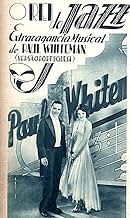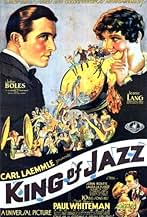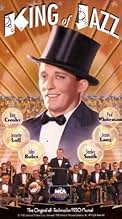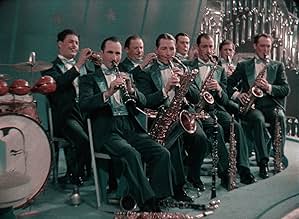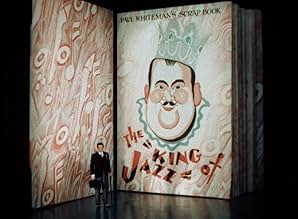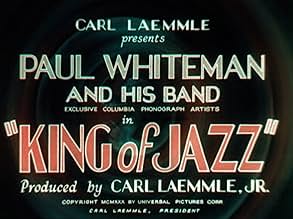NOTE IMDb
6,7/10
1,7 k
MA NOTE
Ajouter une intrigue dans votre langueA rotund bandleader leads a series of theatrical sketches, dance numbers, special effects, and animated segments.A rotund bandleader leads a series of theatrical sketches, dance numbers, special effects, and animated segments.A rotund bandleader leads a series of theatrical sketches, dance numbers, special effects, and animated segments.
- Récompensé par 1 Oscar
- 2 victoires au total
Harry Barris
- One of the Rhythm Boys
- (as The Rhythm Boys)
Bing Crosby
- One of the Rhythm Boys
- (as The Rhythm Boys)
Al Rinker
- One of the Rhythm Boys
- (as The Rhythm Boys)
Carla Laemmle
- Chorine
- (as Beth Laemmle)
Histoire
Le saviez-vous
- AnecdotesThe animation sequence, created by Walter Lantz, was the first Technicolor animation ever produced.
- GaffesWhiteman's six violinists are introduced playing in two rows of 3's. Then without missing a beat, they are suddenly seen in an overhead shot playing in a circle.
- Citations
Announcer: You don't mean to tell me that you are well-versed in the intricacies of the art of Terpsichore?
Paul Whiteman: No, but I can dance.
- Versions alternativesRestored in 2016 with a running time of 99 minutes. This version replicates the scene continuity of the 1930 release version, including about a minute of exit music. A small amount of footage was not found and is covered by still photographs. This is the version that played at the Museum of Modern Art and Film Forum in 2016, and was released by the Criterion Collection on Blu-ray and DVD in 2018.
- ConnexionsFeatured in The All Talking, All Singing, All Dancing Show (1973)
- Bandes originalesRhapsody in Blue
(uncredited)
Music by George Gershwin
Played briefly during the opening credits
Played by Paul Whiteman and Orchestra (as "The Paul Whiteman Orchestra") during the production number
Performed by Roy Bargy (piano)
Danced by Jacques Cartier with clarinet, along with the Russell Markert Girls and The Sisters G
Commentaire à la une
1930's King of Jazz is the strangest and most surreal of the early sound cycle of movie studio revues. Very few films shot completely in two-strip Technicolor survive - this is one of them. Warner Bros. probably made the most all-Technicolor films in the early sound era, but since most of them were Vitaphone the films have long since been lost in most cases.
The 1929 and 1930 early sound revues were made by the studios primarily to showcase their talent in an all-talking setting. MGM's "Hollywood Revue of 1929" started the cycle, and did a pretty good job. However, other studios lost sight of the goal and the revues that followed were often clumsily put together and didn't even showcase talent that belonged to the studio.
"The King of Jazz" is a surprise not only because it holds up so well with time, but because it is such a non-typical product for Universal Studios of that era. Universal of the 20's and 30's mainly made westerns for rural moviegoers with an occasional prestige picture and they were beginning to dabble in the horror genre for which the studio is most remembered. However, at this time they were also known for their thrift, which went out the window when they made this film. The film starts out with a cartoon showing how Paul Whiteman - who called himself The King of Jazz - discovered Jazz. What follows are a sequence of musical and comedy routines. This film doesn't make the mistake of trying to sew the numbers together with some maudlin backstage melodrama. It simply presents the numbers in sequence. Most of the talent here is not under long-term contract to Universal. Laura LaPlante is one of the rare exceptions to that rule. The musical numbers are a delight and it is great to see Bing Crosby at the very beginning of his career. The Brox Sisters light up this film just as they did MGM's revue with "Singin in the Rain". The whole thing is so lively and done with with such innovation and energy considering the static camera of the early talkie era that I can't believe Universal has never thought to put this on DVD. They made this one great musical and didn't really make another one until 1936's "Showboat".
My favorite number is "Song of the Dawn" featuring handsome John Boles with his piercing eyes in close up during most of the number belting out a song with that wonderful tenor voice of his. The most memorable number though has got to be "Happy Feet" with dancing shoes and the Sisters G as singing heads in a shoebox. This number also has the aptly named Al "Rubber Legs" Norman showing us the moon dance 28 years before Michael Jackson was even born.
Highly recommended for the fun of it all.
The 1929 and 1930 early sound revues were made by the studios primarily to showcase their talent in an all-talking setting. MGM's "Hollywood Revue of 1929" started the cycle, and did a pretty good job. However, other studios lost sight of the goal and the revues that followed were often clumsily put together and didn't even showcase talent that belonged to the studio.
"The King of Jazz" is a surprise not only because it holds up so well with time, but because it is such a non-typical product for Universal Studios of that era. Universal of the 20's and 30's mainly made westerns for rural moviegoers with an occasional prestige picture and they were beginning to dabble in the horror genre for which the studio is most remembered. However, at this time they were also known for their thrift, which went out the window when they made this film. The film starts out with a cartoon showing how Paul Whiteman - who called himself The King of Jazz - discovered Jazz. What follows are a sequence of musical and comedy routines. This film doesn't make the mistake of trying to sew the numbers together with some maudlin backstage melodrama. It simply presents the numbers in sequence. Most of the talent here is not under long-term contract to Universal. Laura LaPlante is one of the rare exceptions to that rule. The musical numbers are a delight and it is great to see Bing Crosby at the very beginning of his career. The Brox Sisters light up this film just as they did MGM's revue with "Singin in the Rain". The whole thing is so lively and done with with such innovation and energy considering the static camera of the early talkie era that I can't believe Universal has never thought to put this on DVD. They made this one great musical and didn't really make another one until 1936's "Showboat".
My favorite number is "Song of the Dawn" featuring handsome John Boles with his piercing eyes in close up during most of the number belting out a song with that wonderful tenor voice of his. The most memorable number though has got to be "Happy Feet" with dancing shoes and the Sisters G as singing heads in a shoebox. This number also has the aptly named Al "Rubber Legs" Norman showing us the moon dance 28 years before Michael Jackson was even born.
Highly recommended for the fun of it all.
Meilleurs choix
Connectez-vous pour évaluer et suivre la liste de favoris afin de recevoir des recommandations personnalisées
- How long is King of Jazz?Alimenté par Alexa
Détails
Box-office
- Budget
- 2 000 000 $US (estimé)
- Durée1 heure 39 minutes
Contribuer à cette page
Suggérer une modification ou ajouter du contenu manquant


